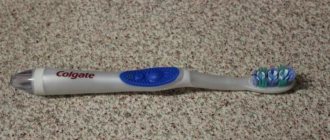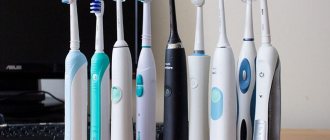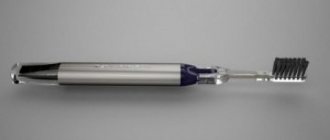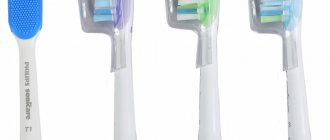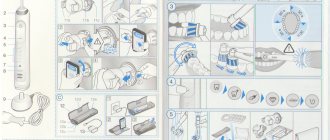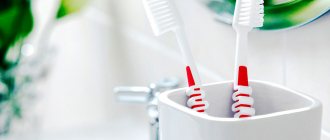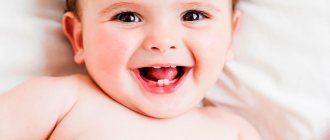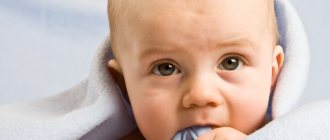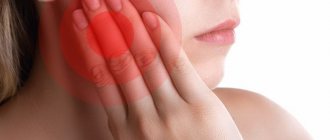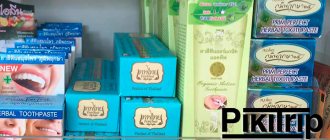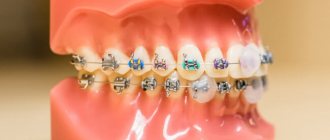The cutting of a baby's first teeth is a very exciting and important period in the life of parents, for which you need to prepare several weeks in advance. We are talking about the features of the hygienic regime and proper oral care. Some mothers believe that a child’s teeth should be brushed after the first baby tooth appears, but dentists have a different opinion. You should not take the issues of oral hygiene in infancy lightly, because not only the health of your teeth, but also the correct formation of your bite will depend on this.
Baby's first tooth
The mucous membranes also need daily cleansing of bacteria and food debris, since it is the surface layer of the gums that provides local immunity and helps prevent the development of many infectious pathologies. To clean the mouth of a child under 1 year old, the same hygiene products are used as for older children, but they must be selected in accordance with age characteristics and needs.
Toothbrush for babies
When to start?
A very common misconception of many parents is the belief that they need to start caring for the baby’s oral cavity after the first baby teeth erupt. In fact, gums and mucous membranes need special care almost from the very birth of the baby. It is impossible to use professional hygiene products at this age due to the content of chemical elements and compounds that can negatively affect the protective functions of the epithelial layer covering soft tissues.
When and at what age is it better to start brushing your teeth?
To remove residual milk or formula, you can wipe the inner surface of the cheeks, gums and tongue with a sterile gauze cloth moistened with boiled water. When the baby is one month old, water can be replaced with herbal infusions and decoctions. They help moisturize and soothe the baby's gums and prevent the development of inflammatory processes that often occur due to the accumulation of dairy foods in the oral cavity. Parents should know that milk sugars are an excellent breeding ground for the proliferation of fungal flora and the occurrence of candidal stomatitis. The main food of infants up to six months of age is breast milk or milk substitutes, so hygiene procedures are an integral part of oral health in children, starting from birth.
Candidal stomatitis in children
The following herbs can be used to prepare a decoction or infusion:
- chamomile (considered a plant with hypoallergenic properties and is almost always well tolerated by infants);
- calendula (a powerful antiseptic with bactericidal and anti-inflammatory effects);
- sage (soothes gums and destroys pathogenic flora);
- St. John's wort (contains many mineral salts and vitamins, has a positive effect on the condition of gum tissue).
Important! It is not recommended to use decoctions and infusions more than 1-2 times a week, since frequent use can disrupt the natural balance of microflora.
Lactation
The first toothbrush for a child - how to choose
He will get his first toothbrush at 1 year of age. From now on, you need to accustom him to daily cleaning in the morning and evening, so that at 3 years old he does it himself and without whims.
Stores sell brushes for children that are marked with too wide an age range - from 1 to 7 years. However, during this time several types of brushes will change. Until the age of 2, it will be very soft with a head size of 1.5 cm and a handle length of about 10 cm. From 2 to 5, he will begin to use a brush with a head of 2 cm and a handle of 13-17 cm. After 5, the head size will be from over time, increase to about 2.5 cm until the child grows up and begins to brush his teeth with a regular brush or an electric one.
The first model should be equipped with silicone or rubber bristles, which cannot damage the soft tissues of the oral cavity. The procedure is carried out by adults, gradually teaching the baby to use hygiene products independently. At this age, it is important to create the habit of brushing your child’s teeth twice a day. When there are a lot of them, you will need to buy a brush with soft bristles.
What are dental wipes for?
Dental wipes are designed to remove food debris and microbial plaque from a baby's gums and are an alternative to a toothbrush for children under 5-8 months. Most wipes are approved for use from 4 months due to the content of sodium salts of benzoic acid. They are used in the food industry as a preservative and are officially considered a food additive.
Dental wipes Asepta baby
You can also find other components in the composition, the use of which is contraindicated before four months of age. These include:
- lemon acid;
- sodium citrate;
- xylitol (a type of sugar found in many grains, berries and fruits).
“Toothpicks” - napkins soaked in xylitol
Glycerin is used as a softening base, and the impregnation formula may contain plant extracts, for example, green tea, chamomile or calendula extract. This composition helps to provide comprehensive care for the child’s gums and prevent infectious and inflammatory processes.
Note! The most popular brand of dental wipes for infant gum care is Spiffies. One package contains 20 hermetically sealed fruit-scented wipes, suitable for daily use from four months of age. The only disadvantage of this product is the high cost (about 500 rubles per pack).
Spiffies dental wipes
The role of hygiene care in infancy
Dentists recommend buying a special toothbrush for cleaning the first baby teeth from the moment the first tooth appears. Some mothers do not see the need to care for baby teeth, although the health of the permanent dentition will depend on the condition of the first teeth. A tooth affected by caries is a source of constant infection, which can penetrate into the deep layers of the periodontium and periodontium. With such a clinical picture, an erupted molar may also appear with a carious cavity, which will be much more difficult to treat.
We must also not forget that healthy baby teeth ensure the correct formation of the facial skeleton and bite. Statistics show that almost 17% of depressive disorders and childhood complexes are associated with malocclusion and other oral defects. This can be avoided if you seek dental care in a timely manner and pay enough attention to preventive measures.
Dental care
Choosing a brush - what you need to know?
Toothbrushes for infants are made only from soft materials that will not scratch or damage the gums. Almost 80% of products in this group are made of silicone, since this material has many advantages:
- ease of hygienic care;
- softness and minimal trauma;
- absence of dangerous compounds in the composition;
- moderate massage effect.
Silicone toothbrush for finger
The downside of silicone brushes is their fragility. The consumer characteristics of such brushes deteriorate after about 1-2 months of use. This is also due to the physiological characteristics of this age, because in the period from 4-5 to 8-10 months, all babies experience intensive eruption of baby teeth. This process is very painful, accompanied by swelling of the gums and constant itching, so the child tries to chew and gnaw everything that gets into his mouth and touches the gums.
Silicone finger brush for babies
Important! You need to change your baby brush promptly. This is due not only to the hygienic aspect, but also to the possible entry of small pieces of silicone into the baby’s respiratory tract. If, upon inspection of the product, any signs of deformation and damage to the integrity of the material from which the brush is made are revealed, it should not be used - this can be dangerous to the health and life of the child.
What is a silicone toothbrush?
For your information! Silicone toothbrushes are an innovative development that allows you to brush your teeth with increased comfort.
The products have a long service life, are not afraid of high temperatures, and do not deform over time.
The material from which such cleaning devices are made is thermoplastic polyurethane.
Implants are made from it.
Absolutely safe for health .
The design differs somewhat among different manufacturers: in some models the bristles are the same height and size, in others there is a gradation in thickness and height.
What does a baby brush look like?
The silicone brush is a soft fingertip that fits onto the finger of an adult. Before each use of a brush, parents should wash their hands with antibacterial soap to avoid introducing infection into the child’s mouth. Using a brush placed on your finger, you need to make gentle, slow movements on all sides of the gums, not forgetting to pay attention to hard-to-reach areas where plaque most often accumulates.
What does a baby toothbrush look like?
The duration of the procedure in children from 4-5 months to 1 year should be slightly longer than in older children, because 2 minutes will not be enough to completely remove plaque and food debris. On average, dentists advise spending at least 4-5 minutes on hygiene measures. This will not only help remove all impurities, but also provide gum massage, improve blood circulation and help reduce the severity of pain during teething.
Brushing your teeth should last at least 4-5 minutes
The very first oral hygiene products
A child’s very first toothbrush can be a special finger attachment , with which the child’s mother will wipe and massage his gums and barely erupted first teeth. This model of a baby brush is essentially an ordinary silicone cap with soft short hairs or pimples, which the mother will put on her index finger and massage her gums, as well as clean her mouth of food debris. It should be used after the child wakes up, eats and before bedtime. To do this, you need to wet the finger on which the cap is placed with boiled water and gently wipe the child’s gums. After use, such a brush should be washed well with soap, dried and placed in a clean container with a lid. The brush changes as the silicone hairs wear out. It is advisable to buy this hygiene product at a pharmacy to avoid counterfeits.
With the appearance of the first teeth, in addition to a finger brush, you can buy your child a special baby brush with rubber bristles , designed for a baby up to 1 year old. These bristles are longer than those of a fingertip, and the brush itself has a special, comfortable, rounded handle.
Features of caring for silicone brushes
It is important not only to choose the right brush, but also to know the features of caring for it. Following the recommendations of dentists will help extend the life of your teeth and improve the quality of hygiene procedures. After each use, the product must be washed with warm water and baby or antibacterial soap. You can also use natural laundry soap for this purpose, but after the procedure it must be rinsed thoroughly. If this is not done, a characteristic odor will remain on the product and the child will refuse to brush his teeth.
It is best to store the brush in a special case, but you do not need to put it away immediately after use. After washing, it is better to put it in a clean towel or napkin and leave for 30-40 minutes. This is necessary for the product to dry completely. Regular drying with a towel is not enough for this, because moisture accumulates between the tubercles located on the surface of the brush, and it is quite difficult to dry these places.
Silicone brush with case
Important! Children's personal hygiene products should not be stored together with products intended for adults. Silicone brushes must be stored in a case. Products with bristles should be placed in a glass with the bristles facing up.
silicone brush fingertip
On January 2nd we celebrated Yulka’s one year anniversary and the most difficult year of my life. I hope it gets easier.
About the physical.
The main method of movement for the past four months has been crawling. It crawls quite quickly, the cats only have time to run away. He stands up against any support, including my leg, regularly pulling off my pants. Loves to walk and even run with support from two hands. In this way, he can walk as much as he wants until the driver’s back begs for mercy. As soon as you take one hand, he stops dead in his tracks and begins to look for his hand back or grabs his leg. At the support he moves reluctantly, a few steps along the sofa at most. Loves to climb any low obstacles such as sofa cushions and me. She can’t climb onto the sofa, she’s too small, she’s not tall enough to throw her leg up.
About skills.
He ignores the lamentations of “okay, okay,” but claps with pleasure if you say “How does Yulia clap her hands?” Same thing with waving “hello-bye.” She herself waves to those standing at the threshold; if you wave back, she immediately stops. He shows few body parts and reluctantly, only on toys; for me he only shows his mouth; he doesn’t show anything at all on himself. When he hears “Give”, he makes a characteristic movement with his hand. When he hears the word “Hello,” he puts his hand to his ear. Sniffling shows a hedgehog. She started babbling a month ago, now she has dad, grandma, and mom in her arsenal (she just started talking a week ago). Of course, unconsciously, but thanks for that. He loves to read, but only two books - about Shmyak and “The Favorite Book of Kids” (you guessed it) with nursery rhymes and poems by Barto, Chukovsky, etc. The rest immediately reaches out to close it or simply turns away and crawls away. He shows no interest in the spoon; if you give him freedom in food, he will throw the spoon away and eat his hands. Therefore, I don’t give free rein to the spoon yet.
About food.
GW was curtailed in exactly one year. Before this, feeding was only in the morning, which gradually shifted first to 4 in the morning, then to 5, 6, 7, and eventually she stopped waking up for it. If he wakes up, he is satisfied with stroking and a pacifier. Eats 4 times a day, regularly, a lot. She has already introduced all the main types of foods, eats everything, does not refuse anything. Favorites include porridge with fruit and bread with cookies. I give him the mixture at night and he drinks it with pleasure.
About teeth.
The first appeared at 9.5 months, at the moment there are 4 of them and two more on top. There were no special hysterics about my teeth, but as usual I attribute any bad mood to my teeth. I’m trying to get used to brushing my teeth, first with a silicone fingertip, and now I’ve already bought a brush. In the mornings he sits next to me on the washing machine and moves something in his mouth.
About sleep.
We are in a difficult period of transition from two dreams to one. Two are definitely too many, but one sleep is definitely not enough. A day like this, a day like that. Because of this, the routine has become very loose; we wake up at 7 and go to bed at 10, which we don’t like at all. But there is nothing to be done for now. The first nap is sleeping on the loggia in a stroller, the second nap is short next to the parent on the bed. He also sleeps at night on the bed with his parent, then we transfer him to the crib. Once again I promise myself to start putting myself to bed... On December 17th, a miracle happened - sleeping without waking up all night. Just as I fell asleep at 21:00, I just woke up at 8:30. There have been no more such gifts yet. During the night he usually wakes up three or four times, gets a pacifier, turns over on his side and continues to sleep.
About performance characteristics.
She turned one year old with a weight of exactly 8 kilograms and a height of 68 cm. She looks very small, although quite plump. She successfully walks in size 62 overalls, which I bought for her at the time when she was discharged from the maternity hospital (ha ha). We pass the commission every year, so far there are no complaints.
About different things.
She still loves cats, she even squeaks. Moreover, any kind of cats - he rejoices at the screensaver on his laptop, a video with a kitten on Instagram. Naturally he pursues his own people, trying to pet them as best he can. At the end of the year I got sick for the first time with fever, conjunctivitis and other joys of the flu. He drives terribly in the car, I really hope that changing the car seat will help, otherwise at least stay at home. I began to ride better in a stroller, with virtually no disturbances. He still doesn’t like sharp sounds, and he cries from musical toys.
Do baby brushes need to be sterilized?
Recently, devices for sterilizing children's toothbrushes have appeared on the market, which provide antibacterial treatment using steam. Experts consider the use of sterilizers inappropriate for several reasons.
- The service life of a children's toothbrush is about 2-3 months. After this, it must be replaced, since such a brush loses its hygienic and consumer properties.
- All modern products are made from synthetic materials in which the growth of pathogenic flora is practically impossible. To ensure hygienic treatment and remove bacteria from the surface of the product, it is enough to wash it with warm water and soap.
- Steam treatment can lead to deterioration of the silicone properties and faster deformation of the product.
Brush with silicone bristles
Note ! Under no circumstances should children’s toothbrushes be boiled or doused with boiling water. Modern synthetic materials are not designed for this.
Using a silicone brush
Manufacturers and prices
The table below lists the most popular manufacturers of toothbrushes for babies, as well as approximate prices for their products.
Table. Popular children's toothbrushes and their average market prices.
| Manufacturer | average cost |
| Canpol | 190 rubles |
| Pigeon | 210 rubles |
| "Splat" | Usually comes with “0+” toothpaste. The cost of the set is 210 rubles |
| "Fairy tale" | 100 rubles |
| "Bead" | 210 rubles (storage case included) |
Dentists consider early oral care to be the key to healthy teeth, proper bite and excellent prevention of caries. It has been proven that in children whose parents did not provide sufficient hygienic care in infancy, the first signs of the carious process are detected at the age of 2-3 years. In order not to expose your child to additional risk, it is better to follow the advice of specialists and take responsibility for the condition of the child’s oral cavity.
Baby is cutting teeth
Preventative dental examinations are recommended for children from the moment the first teeth appear, that is, from about six months of age. Ear hurts after wisdom tooth removal, read this link.
